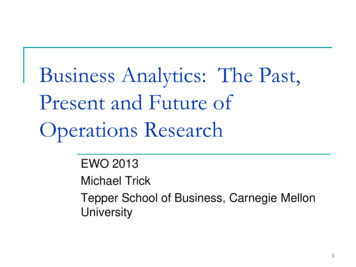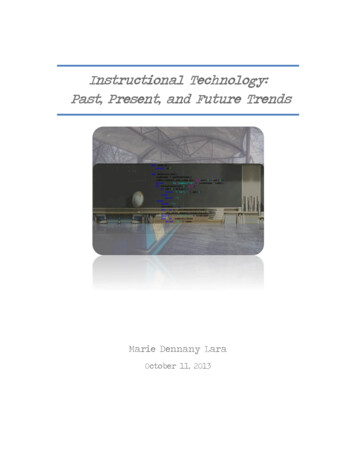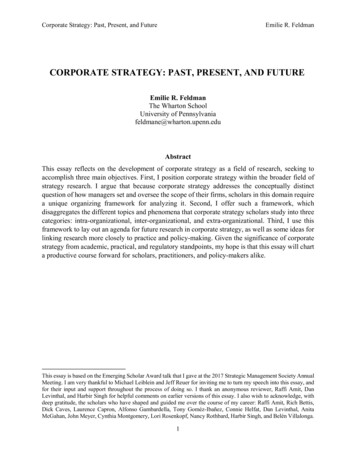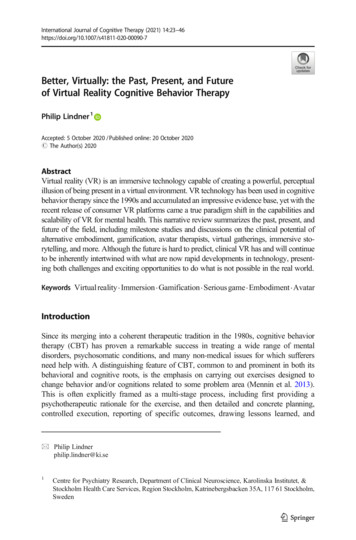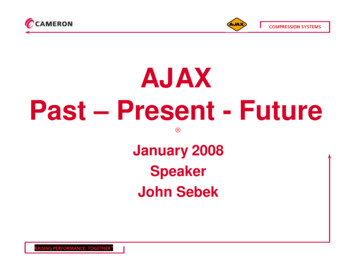
Transcription
DATA VISUALIZATIONPAST, PRESENT, AND FUTURESTEPHEN FEWPERCEPTUAL EDGEWednesday, January 10, 2007
INTRODUCTIONData visualization, the use of images to represent information, is only now becoming properly appreciated for the benefitsit can bring to business. It provides a powerful means both to make sense of data and to then communicate what we’vediscovered to others. Despite their potential, the benefits of data visualization are undermined today by a general lack ofunderstanding. Many of the current trends in data visualization are actually producing the opposite of the intended effect,confusion rather than understanding. Nothing going on in the field of business intelligence today can bring us closer tofulfilling its promise of intelligence in the workplace than data visualization. But this will happen only if we understandit and use it properly. We must embrace what really works and jettison the silly stuff that undermines data visualizationtoday.HISTORY OF DATA VISUALIZATIONTo understand current and future trends in the field of data visualization, it helps to begin with some historical context.Despite the fact that predecessors to data visualization date back to the 2nd century AD, most developments have occurredin the last two and a half centuries, predominantly during the last 30 years.Figure 1: History of data visualization timelineThe earliest table that has been preserved was created in the 2nd century in Egypt to organize astronomical information asa tool for navigation. A table is primarily a textual representation of data, but it uses the visual attributes of alignment,white space, and at times rules (vertical or horizontal lines) to arrange data into columns and rows. Tables, along withgraphs and diagrams, all fall into the class of data representations called charts. Although tables are predominantly2 2007 Stephen Few. None of this paper’s content may be altered in anyway or published in part without the review and approval of the author.
textual, their visual arrangement of data into columns and rows was a powerful first step toward later developments,which shifted the balance from textual and visual representations of data.The visual representation of quantitative data in relation to two-dimensional coordinate scales, the most common formof what we call graphs, didn’t arise until much later, in the 17th century. Rene Descartes, the French philosopher andmathematician probably best known for the words “Cogito ergo sum” (“I think therefore I am”), invented this methodof representing quantitative data originally, not for presenting data, but for performing a type of mathematics based on asystem of coordinates. Later, however, this representation was recognized as an effective means to present information toothers as well.Following Descartes’ innovation, it wasn’t until the late 18th and early 19th centuries that many of the graphs that we usetoday, including bar charts and pie charts, were invented or dramatically improved by a Scottish social scientist namedWilliam Playfair.Over a century passed, however, before the value of these techniques became recognized to the point that academiccourses in graphing data were finally introduced, originally at Iowa State University in 1913.The person who introduced us to the power of data visualization as a means of exploring and making sense of data wasthe statistics professor John Tukey of Princeton, who in 1977 developed a predominantly visual approach to exploringand analyzing data called exploratory data analysis.In 1983 data visualization aficionado Edward Tufte published his groundbreaking book The Visual Display ofQuantitative Information, which showed us that there were effective ways of displaying data visually and then there werethe ways that most of us were doing it, which were sadly lacking in effectiveness. One year later, in 1984, while we werewatching the Super Bowl, Apple Computer introduced the first popular and affordable computer that focused on graphicsas a mode of interaction and display. This paved the way for the use of data visualizations that we could view and interactwith using a computer.Given the availability of affordable computers with powerful graphics, a new research specialty emerged in the academicworld, which was given the name “information visualization.” In 1999 the book Readings in Information Visualization:Using Vision to Think collected this work into a single volume and made it accessible beyond the walls of academia.In addition to these milestones in the development of data visualization, another event in the second half of the 20thcentury greatly influenced the quality of data visualization, but in the wrong direction: the proliferation of the IBM PC.Before the personal computer became commonplace in the workplace, if you needed to present data graphically, youwere faced with a labor-intensive process involving the use of a T-square, draftsmen’s triangles, and a collection of specialpencils and pens. It sometimes took hours to produce a graph that could be displayed in a meeting or attached to a printedreport. When the process took this much time and effort, people responsible for this work usually took time to developgraphical communication skills. But with the advent of the PC and the proliferation of business software such as theelectronic spreadsheet, this changed. With the PC, the click of a mouse could transform a host of numbers into a graph, 2007 Stephen Few. None of this paper’s content may be altered in anyway or published in part without the review and approval of the author.3
and people who knew nothing about graph design suddenly became Rembrandts of graphical communication—or so theyimagined. Despite Edward Tufte’s efforts beginning in the 1980s, the quality of data visualization went largely ignored,especially in form of business graphs, despite their exponential growth.Now that the stage has been set with the backdrop of history, let’s take a look at what’s happening today.CURRENT TRENDS IN DATA VISUALIZATIONToday, data visualization is increasingly taking its rightful place as an important part of business intelligence. It is beingtalked about, investigated, requested by people who work with data, purchased by people who hold the purse strings, andused by a growing percentage of people in the workforce, especially analysts. That’s the good news. The bad news is that,in the world of business, data visualization is still mostly ignored, largely misunderstood, used ineffectively, and too oftenundermined by the very vendors that produce and sell visualization software. The fact that you’re reading this indicatesthat you want to learn about it and take full advantage of what it offers, so let’s start with the good news and save the badnews as a warning about what to avoid for last.Good TrendsData visualization has in recent years become an established area of study in academia. Many universities now havefaculty members who focus on visualization and a few have excellent programs that serve the needs of many graduatestudents who produce worthwhile research studies and prototype applications. This research community consists ofpeople who are not just from computer science, but from many other disciplines as well, such as psychology and evenbusiness, which provides the context for a great deal of innovation while drawing on the robust practices of moremature disciplines.We’re beginning to see some data visualization products that actually work well. It still represents the minority, but agrowing minority. Most of the best commercial visualization software has directly emerged from work that began asacademic research. Efforts are currently under way, including my own, to bridge the gap between academic researcherswith great ideas and business intelligence vendors who know how to build and sell commercially viable softwareproducts.One of the encouraging new trends in business intelligence is the growing recognition that the greatest benefits ofdata visualization will come in the form of analytics. Visual analysis software allows us to not only represent datagraphically, but to also interact with those visual representations to change the nature of the display, filter out what’snot relevant, drill into lower levels of detail, and highlight subsets of data across multiple graphs simultaneously.This makes good use of our eyes and assists our brains, resulting in insights that cannot be matched by traditionalapproaches. Static graphs delivered on paper or electronically on a computer screen help us communicate informationin a clear and enlightening way, which is a benefit that should not be undervalued, but it is from visual analytics thatbusinesses will derive the greatest benefits.4 2007 Stephen Few. None of this paper’s content may be altered in anyway or published in part without the review and approval of the author.
One of the most powerful techniques of visual analysis involves the simultaneous display of multiple graphs, whichfeature either different subsets of data taken from a larger data set, or different views of a shared data set. Edward Tuftepopularized a form of display that he calls small multiples, which uses a series of small graphs arranged together withineye span so they can be compared. Each graph represents a different subset of data belonging to a full data set, such asa series of line graphs that displays a company’s expenses through time, with a separate graph per department. Smallmultiples greatly expand the number of variables (dimensions) that can be viewed together and compared. A differentapproach to the simultaneous display of multiple graphs uses each to examine a different aspect of a common data set. Forinstance, several graphs, perhaps of different types (bar graphs, line graphs, scatterplots, etc.), could be displayed togetherto simultaneously examine several aspects of a data set, allowing us to discover connections in the data that might notever surface if the graphs were viewed separately. Visual analysis products that support displays such as these are rapidlybecoming recognized for the rich analytical insights they make available to our eyes.Despite my enthusiasm for the growing popularity of visual analytics, it is important to mention that something significantis also happening regarding the use of plain old graphs to communicate information. When you have something to say toothers about data that you’ve examined, visual representations such as graphs or diagrams are often the best medium, butonly if you know the language. Visual communication involves semantics and syntax, much like verbal language. You mustknow the rules to communicate effectively with graphs. Today, due in part to the pioneering work of Edward Tufte andWilliam Cleveland beginning in the 1980s, and more recently to the efforts of Gene Zelazny, Naomi Robbins, and myself,the message is getting out that graphical communication requires fundamental skills that must be learned. I believe thatthese skills are quite easy to learn, but they aren’t necessarily intuitive; it requires effort and the right resources.No example of data visualization occupies a more prominent place in the consciousness of business people today thanthe dashboard. These displays, which combine the information that’s needed to rapidly monitor an aspect of the businesson a single screen, are powerful additions to the business intelligence arsenal. When properly designed for effective visualcommunication, dashboards support a level of awareness—a picture of what’s going on—that could never be stitchedtogether from traditional reports. Unfortunately, most dashboard products and most of the vendors that develop and sellthem, fail to take full advantage of data visualization’s power. Instead, these dashboards tend to look and function morelike video games than serious information displays. In fact, many dashboards and dashboard products, while raising thevisibility of data visualization, have only managed to give it a bad name due to poor design.Another expression of data visualization that has captured the imagination of many in the business world in recent years isgeo-spatial visualization. The popularity of Google Earth and other similar Web services have contributed a great deal tothis interest. Much of the information that businesses must monitor and understand is tied to geographical locations. Forinstance, sometimes sales information can only be understood if you can see where those sales are occurring. In such cases,the ability to see measures such as sales revenues on a map adds a dimension of understanding that is critical. The abilityto take advantage of location information that already resides in your systems, such as customers’ zip codes, to displayrelated information such as sales on a map is becoming increasingly available in business intelligence software and betterintegrated into the overall reporting and analysis experience every day. 2007 Stephen Few. None of this paper’s content may be altered in anyway or published in part without the review and approval of the author.5
Another trend that is only now beginning to find its way into business intelligence applications involves the use ofvisual animation (the movement of objects in charts) to show change through time. We have used line graphs forages to effectively represent change through time. This works great when you are focusing directly on time-basedinformation, for instance, measures of Web traffic taken at equal intervals of time, such as daily for the last month. But,what if you want to examine a different relationship between values, but also look at how it varies through time?Consider the correlation between marketing expenses and resulting sales. The best way to examine this correlation ata particular point in time is by using a scatterplot, with marketing expenses measured along the X-axis (the horizontalaxis), sales revenues along the Y-axis (the vert
Data visualization, the use of images to represent information, is only now becoming properly appreciated for the benefits it can bring to business. It provides a powerful means both to make sense of data and to then communicate what we’ve discovered to others. Despite their potential, the benefits of data visualization are undermined today by a general lack of understanding. Many of the .
